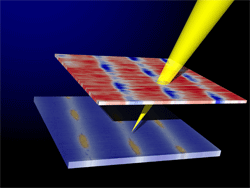
Superconductivity

One hundred years after its discovery, superconductivity is one of the most studied topics in laboratories around the world, both for understanding its origin on fundamental side and for its numerous applications. Abrikosov vortices play an important role in these studies since their mobility is responsible for energy dissipation in superconducting devices and cables. In our laboratory we study the Abrikosov vortices in mesoscopic superconductors and hybrid superconductor/ferromagnet systems.
We are also interested in complex materials that exhibit competing order parameters such as magnetism, superconductivity, charge density waves... We synthesize single crystals and study the behavior of order parameters on several parameters including electronic doping.
Interaction of two (or more) systems with strongly correlated electrons leads to a wealth of physical phenomena. Magnetism and superconductivity are not an exception as their interaction has been studied for decades. With the advent of local scanning probes and nanofabrication, this area of research has experienced a renaissance with the objective to engineer systems that can mimic the behavior of complex single phase compounds exhibiting coexistence of superconductivity and magnetism. The fundamental premise is the engineering of model systems to tailor the dominant interaction between two correlated systems. Recent explorations of the magnetic interaction between a superconductor and a ferromagnet have led to the discovery of intriguing phenomena associated with domain-wall superconductivity and magnetic domain pinning.
In series of works we explore the magnetic interaction between a macroscopically well-ordered magnetic domain state in a ferromagnet and a type-II superconductor with a small coherence length and negligible intrinsic pinning. We show that a re-configurable stripe domain pattern could provide a modulation template in the superconducting condensate. This hybrid system could be a potential playground for testing superconductivity on mesoscopic scale without the need to employ nanoscale lithography techniques. (see papers)
Modulation of the superconducting condensate by the local magnetic domain pattern also serves as a pinning template for Abrikosov vortices. We have studied the Abrikosov vortex configurations in magnetically coupled superconductor-ferromagnet bilayers. The ferromagnet with stripe domain structure induces modulation of the vortex density resulting in formation of vortex chains. In our recent work we elucidate the mechanism of quasi-1D topological vortex phase transitions using both simulations and STM vortex imaging.



